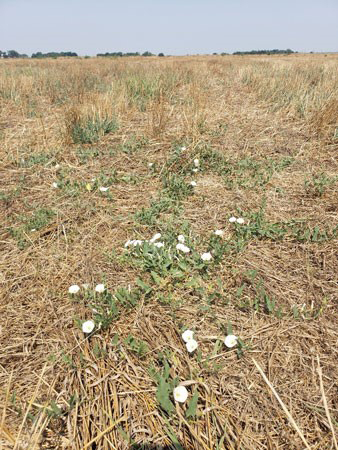Field bindweed (Figure 1) is a particularly troublesome weed to control. In a 12-year experiment conducted at the Agricultural Research Center in Hays, field bindweed reduced wheat yield by 2 to 50%. Management of this weed during wheat establishment is important because field bindweed continues to grow until temperatures drop below 20°F.
The herbicides most commonly recommended for field bindweed control include various formulations of 2,4-D, dicamba, and glyphosate. Dicamba tends to provide greater control for fall applications compared to 2,4-D or glyphosate, especially if plants are drought-stressed. Another commonly used product is Facet (quinclorac). It is most effective when applied just before the first killing frost. Other herbicides that are labeled for fall application to control or suppress field bindweed in wheat include Affinity, Aim, and Cimarron.
A single herbicide application will not achieve satisfactory control of field bindweed. It will take multiple years of herbicide applications to deplete the energy stored in the root system and control an established infestation.

Figure 1. Field bindweed growing in a harvested wheat field. Photo by Sarah Lancaster, K-State Research and Extension.
For additional information, see the “2023 Chemical Weed Control for Field Crops, Pastures, and Noncropland” guide available online at https://bookstore.ksre.ksu.edu/pubs/SRP1176.pdf or check with your local K-State Research and Extension office for a paper copy.
The use of trade names is for clarity to readers and does not imply endorsement of a particular product, nor does exclusion imply non-approval. Always consult the herbicide label for the most current use requirements.
Sarah Lancaster, Extension Weed Science Specialist
slancaster@ksu.edu
Tags: wheat weed control bindweed